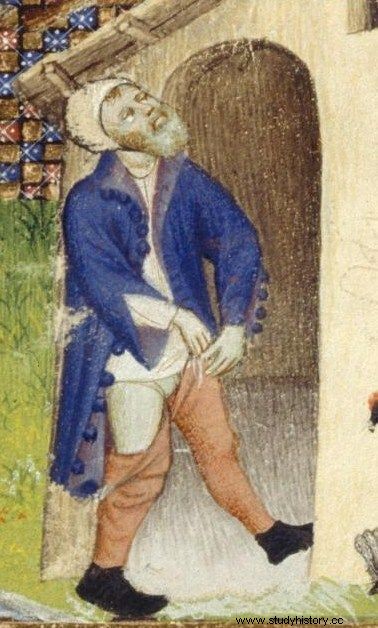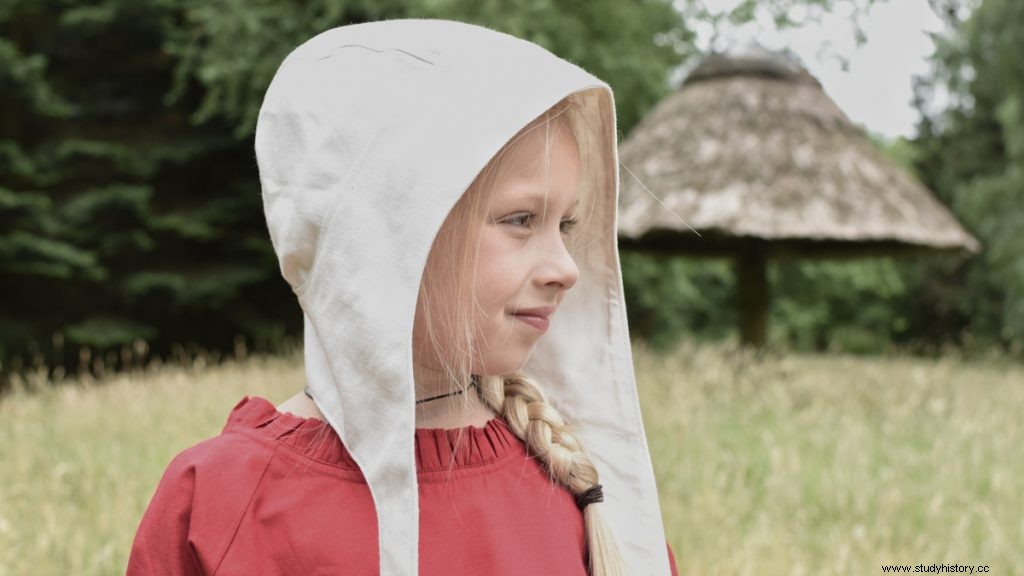Underwear has been worn since time immemorial for two main reasons:on the one hand it protected the outer clothing from the uncleanliness of the human body, on the other hand it protected the body from abrasive materials in the outer clothing. In colder regions, multiple layers of clothing also donated additional warmth. But what did underwear look like in the Middle Ages?
Like pretty much every piece of clothing, the undergarments in the Middle Ages were subject to changes that corresponded to the fashion trends of the respective time and region as well as the respective status. The material used for the underwear was mostly natural, i.e. neither bleached nor dyed. Unlike many outer garments, the undergarments were easy to wash.
Undergarments of women in the Middle Ages
Up until the 16th century, women in trousers were considered wicked, and this also applied to underpants. Therefore, until then, they wore only one undergarment (niderdress) or even several under their outer garments.
Such undergarments were mostly made of a fine material and were about ankle-length. In many illustrations it can be seen that the undergarment protruded from under the overgarment at the neckline, sleeves and skirt hem. If it was a woman from a higher class, sometimes not only the upper garment but also the lower garment was embroidered or provided with braids.
An intermediate form of the undergarment is the chainse. It was usually worn between the undergarment and the overgarment (bliaud or cotte). The chainse was mostly white. A special feature is the neckline, where this type of clothing throws fine wrinkles. In addition, it is often decorated with embroidery or topstitching.
We are often asked:long dresses and then several layers, isn't that impractical? - Not really. In situations where long dresses could have been a nuisance, such as at work, the women knew how to help themselves. In the Codex Manesse, among other things, it can be seen that women workers tied their outer garments upwards through the belt at work, which revealed the somewhat shorter undergarment. This gave them more freedom of movement and protected their outer garments from soiling without showing their legs indecently.
Medieval men's underwear
The man's undergarment consisted primarily of two parts:shirt and a kind of underpants, which probably developed from the loincloth. From the High Middle Ages, men mostly wore two-piece leg clothing consisting of a breech and leggings.
Bruche - the forerunner of modern underpants
The Bruche, also called Bruoch or Brouche, is similar in appearance to today's boxer shorts. Their cut changed over the centuries, depending on the fashion and the cut of the rest of the clothing such as the leg warmers.

The name probably comes from the Latin bracae, which means something like "trousers". Leg warmers were attached to the break. Contemporary illustrations almost always show the breaks in white or natural color.
At first the breaks reached to the knees and were cut rather wide. From the 14th century, fashion brought forth shorter, narrower-cut pieces of clothing, and with it the breeches also changed.
Leg warmers - a mixture of stockings and trousers

Leg warmers are the forerunners of trousers and developed from stocking-like garments that got longer and longer bit by bit. In the 10th century they reached down to the back of the knees, but by the 11th century they were already worn over the knees. A color scheme in Mi-Parti, in which the leg warmers had different colors, was popular.
Leg warmers were first made at the Bruche and later at the Wamsfest. Since leg warmers were cut quite wide in the calf area, the man fixed them there with a garter or with the help of calf wraps.
Incidentally, the word leg is a neologism. The Middle High German term for leg warmers is hose, which would, however, lead to confusion. However, the leg warmers did have a slight effect on the language:it is thanks to them that today it is still called “a pair of trousers”, because a pair of trousers was actually just a pair of leg warmers.
The shirt as a counterpart to the woman's undergarment

The undershirt, also known as the undershirt, was the undergarment for men in the Middle Ages and, like the undergarment, served to protect the upper garment. Although the cut has changed little over the centuries, the length has. The shirt sometimes reached to the knees, sometimes to the base of the thighs or somewhere in between.
The hood - underwear in a broader sense

Underwear on your head, does that make sense? Probably not anymore today, but in the Middle Ages it made sense to put a bonnet under the actual headgear for many reasons. It was part of fashion from the 12th century at the latest and was primarily worn by men and children. Even the king wore a coif under his crown.
Bonnets usually fit snugly on the head and are tied with ribbons under the chin. In most depictions, the bonnet is actually worn closed, even if this sight seems a bit strange to us nowadays. Although there is no find from the Middle Ages that provides information about the exact cut, the pattern can be understood quite well thanks to the numerous illustrations.
The Bundhaube had several functions. So it served to protect against lice and dirt, depending on the season either kept warm or protected the head from the sun. A padded bonnet (padded bonnet) was worn under helmets and mail armor to protect the hair when putting it on and to pad the head against blows. What's also practical about the hood is that headgear worn over it doesn't slip as much as it does on bare hair.
Children's underwear in the Middle Ages
In the Middle Ages, children were little adults. They wore the same cuts as the rest of the population of the time - but in small sizes. This applies to outerwear as well as underwear in the Middle Ages.
